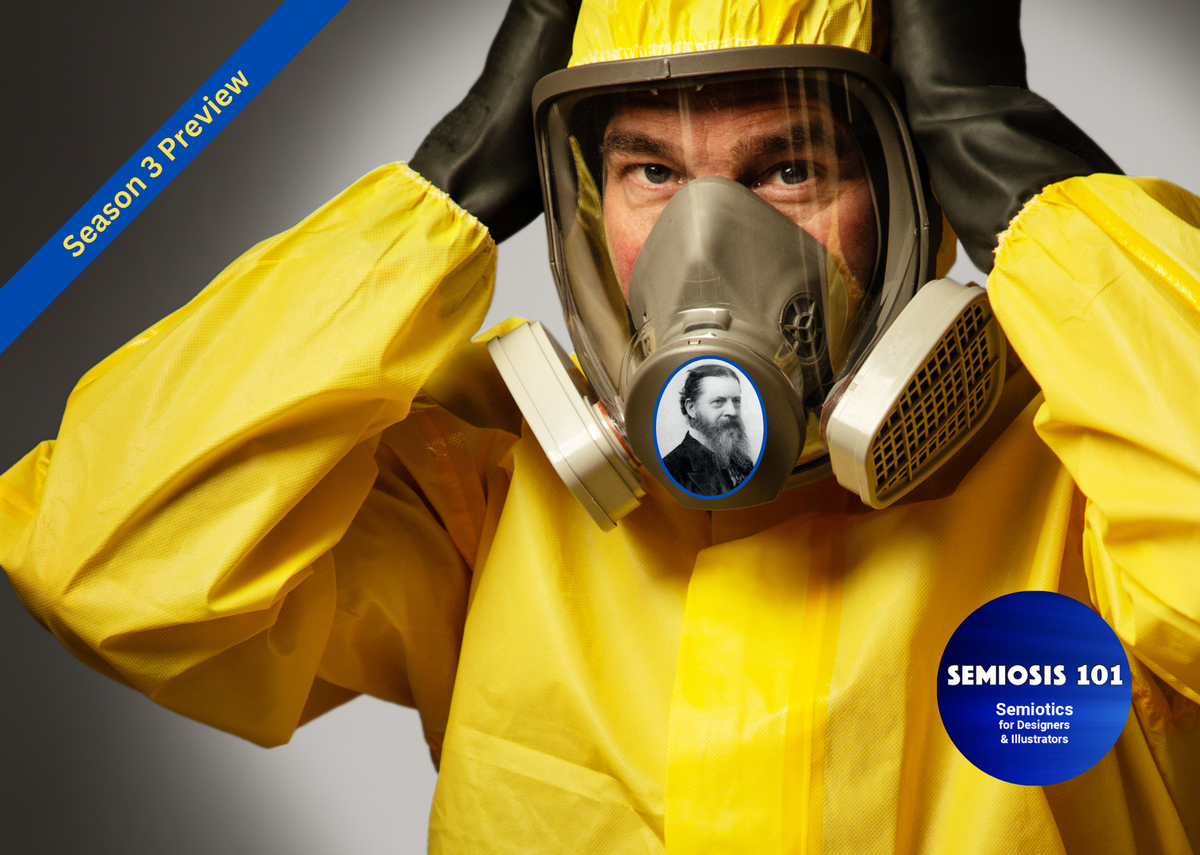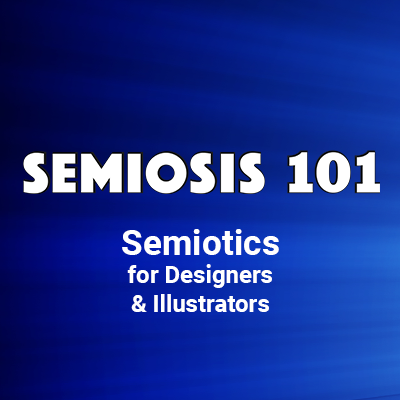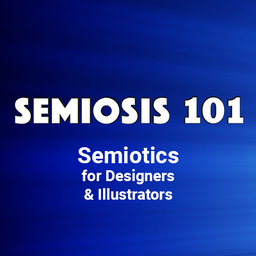Free Semiosis 101 Transcript 3.0:

ENCODING SEMIOTIC SIGN-ACTION: Season Three Preview
Hello readers.
In this free transcript for the episode published on Semiosis 101 on 4 Oct 2023, we preview the new theme of Semiotic Encoding. The main focus is on how audiences make interpretations and at long last you will see what semiotic signs can be/are/will be.
Watch the free episode on YouTube for the full impact… https://youtu.be/tc8JIZmtbis
…and here is the episode’s transcript.
As Semiosis 101 enters its third season of 20 episodes explaining the semiotic theory of Charles Sanders Peirce, we take time in this special episode to preview the next Semiosis 101 theme.
Over the first year we took two seasons to first layout the main tenets of Semiosis - semiotic sign-action - into designer-centric language. Now as we enter the second year and third season, we are ready to focus in on actually encoding semiotic sign-action into visual communication work.
There is still a lot of Peirce’s semiotic theory to put into designer-centric terms. But we have already translated enough semiotic theory into designer-centric terms, we are now prepared for this season’s theme of Semiotic Encoding.
This will not be a How-To manual - semiotics does not work in the same way as learning how to use, say, Adobe Creative Suite.
In Season 1, those 20 episodes framed the main thrust of Peirce’s Pragmatic semiotic theory, into reference episodes establishing the key language and theoretical positions. Season 2’s theme of a Semiotic Rosetta Stone referenced those key Peircean positions.
Season 2 provided new philosophical lenses, through which YOU creatives can reposition your own approach to semiotic ideation. This Semiotic Rosetta Stone theme used a creative meta-language to explain Peirce to designers and illustrators. By centring encoding of semiotic sign-action directly in the research and ideation phases of any design or illustration.
In both seasons I prepared you creatives to consider a more phenomenological mindset, to enhance how YOU visually communicate to YOUR target audiences. Even though Semiosis 101 centres the creative in the semiotic theory, the creative must learn to centre the target audience in YOUR semiotic encoding.
Season 2 used a macro analogue to Peirce’s three-point semiotic determination flow, as a flow between a client, a creative and the target audience. We spent time on exploring how to understand your target audience, in order to discover what familiar experienced qualities can kick start Semiosis. We explored this through several trips of example that were meaningful to designers and illustrators.
Now in Season 3 we are ready to draw on more firmer examples of how to encode your ideas with semiotic signs, to enhance the effectiveness of your visual communication abilities. These examples will still be general. It is up to you all to craft how YOU will apply Semiosis in YOUR work, to enhance the effectiveness of YOUR visual communication to YOUR target audience. So let us quickly lay out how.
In Season 2 episode 2.18 I left you all on a terminology cliff hanger, which I promised would be addressed the following week. That was amiss of me, as I was not ready to actually discuss the term “visent,” before I had discussed the Ice Age roots of what we now call visual communication. This is a term that a fellow Peircean designer-semiotician Steven Skaggs uses, to describe the visual meaning-bearing elements within visual communication. He describes the visent as the visual entity (vis-ent, get it?)
Now that we are about to begin season three, this is a good point in time to begin to describe the thing we design or illustrate, which is semiotically encoded. Skaggs’ book FireSigns focuses solely on graphic design and Peircean semiotics, whereas Semiosis 101’s remit is broader.
Semiosis 101 focuses on both designers AND illustrators AS visual communicators. While both sets of creators are visual communicators, their practice and approach in how they visually communicate naturally differs. So in the first four season three episodes (I have also decided to call the videos “episodes” now), we will prepare the ground for semiotically encoding by discussing what are meaning-bearing elements we design or illustrate.
Then in the next set of three episodes we will focus on what are the visual communication ‘building blocks,’ which we can semiotically encode to enhance your success at hooking audience attention. At this point we will be half way through the season. We will be informed enough by then to dig a little deeper into Peirce’s semiotic theory, to examine ideation AS semiotic sign-action in sketchbooks and ideas development.
In season one and two we have focused on explaining how Semiosis works from the point of representing the concept (or in Peirce’s obtuse terminology - representation of the Object). Now it is time to move to the interpretation (in Peircean terms we will be focusing on explaining the Interpretant). This means we will spend time on semiotically encoding for successful interpretations by the target audience.
Following on from this, in the next three episodes we will return to Peirce’s ten classifications of semiotic signs. From simple to complex. Now that we will have examined interpretation, we will again explore what these ten signs are, and how they can help creatives to semiotically structure your thinking to HOOK your target audience’s attention.
Finally, season three will conclude with three episodes focussing on examples of Semiosis-in-action during ideation.
So, whether you are a visual communicator - a designer …an illustrator - or just an interested party in understanding semiotics (and how it can be applied), Semiosis 101 season 3 will be your guide. Now that seasons 1 and 2 can be referred to for more detail, season 3 will still focus on this channel’s viewers as beginners - whether you are a student or a senior designer.
In the next 20 Semiosis 101 episodes, we will begin each episode with a basic question on HOW. Each HOW question will focus on a simple matter that always worries the novice. In the spirit of the ENCODING theme, the Semiosis 101 episode will answer it in the most direct way possible. That is to say, the answer will only provoke more questions as your confidence grows.
So, do not be shy. Remember there are no stupid questions. Ask YOUR question in the comments. By commenting below with your semiotic questions, we engage in a conversation to grow a designer-centric confidence in applying Semiosis together.
We saw in Season 2 how the Semiotic Rosetta Stone metaphor unlocked ways to hack semiotics to visually communicate and connect with your target audience. In our visual communication work, we produce various outcomes using appropriate visual language.
It is in how this visual language, these aesthetic choices we make, can be semiotically empowered to visually hook the attention of our target audience. This is what we mean by sign-action …or Semiosis as Peirce names it. By learning HOW to apply Semiosis to tailor your visual language you can learn to connect at a deeper level with your audience.
So that is our Semiosis 101 season 3 preview. Over Semiosis 101’s first year of publishing over 50 ten minute full episodes and hundreds of YouTube shorts, its subscriber base is growing. I invite my Semiosis viewers to join the semiotic conversation by subscribing to this free YouTube channel.
This new Semiosis 101 season sees some really exciting additional semiotic resources going fully live. Semiosis 101 is free on YouTube but each video takes up quite a lot of production time to get it live. Semiosis 101 now launches two additional services to future-proof the channel and offer exclusive access to supporters to semiotic additional resources.
I am pleased to announce a Semiosis 101 Substack for written resources, and a Semiosis 101 Patreon for exclusive video resources. Each have its own subscription tiers. In 2022 I did a soft launch of a Semiosis 101 semiotic resource on Substack has now gone fully live (now semiosis101.online). For free subscribers can download episode transcripts, previews of 5-minute semiotic reads and various essays on Semiosis. There is a lot of free information here.
There will be a new 5-minute read each week. The paid semiosis101.online subscription levels provide Semiosis 101 financial backers with richer semiotic detail. Apart from the cool Semiosis 101 exclusive subscriber gifts, you will get un-restricted access to all the semiotic 5-minute reads and comprehensive semiotic, philosophy and design annotated reading lists. Paid subscribers also get to exclusively preview and support a Semiosis 101 manuscript as I write it for publication and get a credit in future YouTube videos. The semiosis101.online link is in the description below.
On Semiosis 101 Patreon I send an open invite to subscribers to become a Semiosis 101 producer too. You will get a producer credit at the end of all future Semiosis 101 episodes. There are four Semiosis 101 Patreon membership tiers to cover all budgets. When you subscribe to Semiosis 101’s new Patreon account, your financial support unlocks access to exclusive non-YouTube video content, behind-the scenes glimpses, and exclusive semiotic projects as they creatively happen.
Patreon subscribers also get access to all future Semiosis 101 episodes months before they appear on YouTube. Whichever way you desire to engage with Semiosis 101, whether for free on YouTube or as a special Semiosis 101 member/subscriber/producer, Semiosis 101’s designer-centric application of Peircean semiotics into practice will now continue this season and beyond.
Semiosis 101 Semiotic Design Resources is a reader-supported publication. To receive exclusive posts and support my work, consider becoming a free or paid subscriber. Paid subscribers get name checked on all future Semiosis 101 YouTube episodes.
===Semiosis 101 Patreon Producer==============
Become a Semiosis 101 Patreon Producer and get a named producer credit on future video episodes, plus watch all new episodes months ahead of YouTube.
===Semiosis 101 Patreon Exclusives==============
Watch longer Patreon-exclusive Semiosis 101 episodes on applying Semiosis into design and illustration…
PATEXC001 How does semiotics work in illustration?





